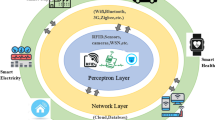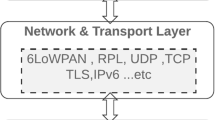Abstract
In this paper, we have exploited the weight trusted routing (WTR) mechanism to detect and eliminate the malicious nodes involved during the routing path formation in smart-home environments where the routing between the communicating entities is performed through the mesh architecture. Further, to provide a secure communication against malicious behavior of nodes, the proposed mechanism uses Dijkstra’s shortest path routing algorithm in which the weights are deliberated using certain parameters such as node-distance, packet-loss and trust value of each node which is computed using social impact theory optimizer. Moreover, we have presented the network performance trade-off caused by secure path formation with conventional method and have proposed the WTR mechanism for eliminating the potential issues such as packet-loss ratio, end-to-end delay and network throughput. The commercial simulator NS2 is used to simulate and compare the network metrics for both conventional as well as proposed approach and is validated with experimental results over end-to-end delay and message delivery ratio against reported literature.








Similar content being viewed by others
References
Silva, L. C. D., Morikawa, C., & Petra, I. M. (2012). State of the art of smart home. Engineering Applications of Artificial Intelligence, 25(7), 1313–1321.
Coutaz, J., & Crowley, J. L. (2016). A first-person experience with end-user development for smart homes. IEEE Pervasive Computing, 15(2), 26–39.
Domaszewicz, J., Lalis, S., Pruszkowski, A., Koutsoubelias, M., Tajmajer, T., Grigoropoulos, N., et al. (2016). Soft actuation: smart home and office with human-in-the-loop. IEEE Pervasive Computing, 15(1), 48–56.
Namasudra, S., & Roy. P. (2015). Size based access control model in cloud computing. In Proceedings of the IEEE international conference on electrical, electronics, signals, communication and optimization, Visakhapatnam (pp. 1–4).
Gopalakrishnan, I. (2011). Wireless mesh routing in smart utility networks. Ph.D. Thesis, Auburn University.
Namasudra, S., Nath, S., & Majumder, A. (2014). Profile based access control model in cloud computing environment. In Proceedings of the IEEE international conference on green computing, communication and electrical engineering, Coimbatore (pp. 1–5).
Garzon, C., Camelo, M., Vila, P., & Donoso, Y. (2015). A multi-objective routing algorithm for wireless mesh network in a smart cities environment. Journal of Networks, 10(1), 60–69.
Iyer, G., Agrawal, P., & Cardozo, R. S. (2013). Performance comparison of routing protocols over smart utility networks: A simulation study. In Proceedings of IEEE Globecom workshops (GC workshops), Atlanta, GA (pp. 969–973).
Majumder, A., Namasudra, S., & Nath, S. (2014). Taxonomy and classification of access control models for cloud environments. In Z. Mahmood (Ed.), Continued rise of the cloud (pp. 23–53). London: Springer.
Mendes, T. D. P., Godina, R., Rodrigues, E. M. G., Matias, J. C. O., & Catalao, J. P. S. (2015). Smart home communication technologies and applications: Wireless protocol assessment for home area network resources. Energies, 8(7), 7279–7311.
Namasudra, S., Roy, P., Vijayakumar, P., Audithan, S., & Balamurugan, B. (2017). Time efficient secure DNA based access control model for cloud computing environment. Future Generation Computer Systems. doi:10.1016/j.future.2017.01.017.
Rehman, S. U., & Manickam, S. (2016). A study of smart home environment and its security threats. International Journal of Reliability, Quality and Safety Engineering, 23(3), 1–9.
Iyer, G., Agrawal, P., & Cardozo, R. S. (2013). Analytic model and simulation study for network scalability in smart utility networks. In Proceedings of IEEE innovative smart grid technologies-Asia (ISGT Asia), Bangalore (pp. 1–6).
Namasudra, S., & Roy, P. (2016). Secure and efficient data access control in cloud computing environment: A survey. Multiagent and Grid Systems, 12(2), 69–90.
Bala, S., Sharma, G., & Verma, A. K. (2016). PF-ID-2PAKA: Pairing free identity-based two-party authenticated key agreement protocol for wireless sensor networks. Wireless Personal Communications, 87(3), 995–1012.
Namasudra, S., & Roy, P. (2016). A new secure authentication scheme for cloud computing environment. Concurrency and Computation: Practice and Exercise. doi:10.1002/cpe.3864.
Huang, H., Gong, T., Chen, P., Malekian, R., & Chen, T. (2016). Secure two-party distance computation protocol based on privacy homomorphism and scalar product in wireless sensor networks. Tsinghua Science and Technology, 21(4), 385–396.
Jhaveri, R. H., & Patel, N. M. (2016). Attack-pattern discovery based enhanced trust model for secure routing in mobile ad-hoc networks. International Journal of Communication Systems. doi:10.1002/dac.3148.
Anita, X., Bhagyaveni, M. A., & Manickam, J. M. L. (2015). Collaborative lightweight trust management scheme for wireless sensor networks. Wireless Personal Communications, 80(1), 117–140.
Labraoui, N., Gueroui, M., & Sekhri, L. (2016). A risk-aware reputation-based trust management in wireless sensor networks. Wireless Personal Communications, 87(3), 1037–1055.
Xi, C., Liang, S., Jian Feng, M. A., & Zhuo, M. A. (2015). A trust management scheme based on behavior feedback for opportunistic networks. China Communications, 12(4), 117–129.
Kerrache, C. A., Calafate, C. T., Cano, J. C., Lagraa, N., & Manzoni, P. (2016). Trust management for vehicular networks: An adversary-oriented overview. IEEE Access, 4, 1–15.
Namasudra, S., & Roy, P. (2017). A new table based protocol for data accessing in cloud computing. Journal of Information Science and Engineering, 33(3), 585–609.
Namasudra, S., & Roy, P. (2017). Time saving protocol for data accessing in cloud computing. IET Communications. doi:10.1049/iet-com.2016.0777.
Salima, S., Obaidat, M. S., Zarai, F., & Hsiao, K. F. (2015). A new secure and efficient scheme for network mobility management. Journal of Security and Communications, Networks, 8(7), 1360–1377.
Sun, L., Pinyi, R., Qinghe, D., & Yichen, W. (2016). Fountain-coding aided strategy for secure cooperative transmission in industrial wireless sensor networks. IEEE Transactions on Industrial Informatics, 12(1), 291–300.
Sultana, S., Ghinita, G., Bertino, E., & Shehab, M. (2015). A lightweight secure scheme for detecting provenance forgery and packet drop attacks in wireless sensor networks. IEEE Transactions on Dependable and Secure Computing, 12(3), 256–269.
Boushaba, M., Hafid, A., & Gendreau, M. (2016). Source-based routing in wireless mesh networks. IEEE Systems Journal, 10(1), 262–270.
Neumann, A., Lopez, E., Cerda, A. L., & Navarro, L. (2016). Securely-entrusted multi-topology routing for community networks. In Proceedings of 12th annual conference on wireless on-demand network systems and services (WONS), Cortina d’Ampezzo (pp. 1–8).
Talawar, S. H., & Ramesh, C. H. (2015). A protocol for end-to-end key establishment during route discovery in MANETs. In Proceedings of 29th international conference on advanced information networking and applications (AINA), Gwangju (pp. 176–184).
Benitez, Y. I. S., Ben, O. J., & Claude, J. P. (2014). Performance evaluation of security mechanisms in RAOLSR protocol for wireless mesh networks. In Proceedings of IEEE international conference on communications (ICC), Sydney, June 2014 (pp. 1808–1812).
Wang, H., Chin, K., & Soh, S. (2016). On minimizing data forwarding schedule in multi transmit/receive wireless mesh networks. IEEE Access, 4, 1570–1582.
Darehshoorzadeh, A., Robson, G., & Azedine, B. (2015). Towards a comprehensive model for performance analysis of opportunistic routing in wireless mesh networks. IEEE Transactions on Vehicular Technology. doi:10.1109/TVT.2015.2457680.
Sbeiti, M., & Wietfeld, C. (2014). One stone two birds: On the security and routing in wireless mesh networks. In Proceedings of IEEE wireless communications and networking conference (WCNC), Istanbul (pp. 2486–2491).
Babu, M. R., & Usha, G. (2016). A novel honey pot based detection and isolation approach (NHBADI) to detect and isolate black hole attacks in MANET. Wireless Personal Communications, 90(2), 831–845.
Poongodi, T., & Karthikeyan, M. (2016). Localized secure routing architecture against cooperative black hole attack in mobile ad hoc networks. Wireless Personal Communications, 90(2), 1039–1050.
Khan, S., Loo, K. K., Mast, N., & Naeem, T. (2010). SRPM: Secure routing protocol for IEEE 802.11 infrastructure-based wireless mesh networks. Journal of Network and Systems Management, 18(2), 190–209.
Khan, S., Alrajeh, N. A., & Loo, K. K. (2012). Secure route selection in wireless mesh networks. Computer Networks, 56(2), 491–503.
Rathee, G., & Saini, H. (2016). Weight trusted routing mechanism for hierarchical mesh environments. International Journal of Distributed Systems and Technologies, 8(3), 25–42.
Macas M., & Lhotska L. (2007) Social impact theory based optimizer. In: F. Almeida e Costa., L.M. Rocha., E. Costa., I. Harvey., A. Coutinho (Eds) Advances in Artificial Life. ECAL 2007. Lecture notes in computer science, vol. 4648, (pp. 635–644). Springer, Berlin.
Matti, T., & Jorma, S. (2001). Dijkstra’s shortest path routing algorithm in reconfigurable hardware. In Proceedings of 11th international conference on field-programmable logic and applications, Belfast, Northern Ireland (pp. 653–657).
Acknowledgements
The authors are sincerely thankful to the anonymous reviewers for critical comments and suggestions to improve the quality of the manuscript.
Author information
Authors and Affiliations
Corresponding author
Rights and permissions
About this article
Cite this article
Rathee, G., Saini, H. & Singh, G. Aspects of Trusted Routing Communication in Smart Networks. Wireless Pers Commun 98, 2367–2387 (2018). https://doi.org/10.1007/s11277-017-4978-5
Published:
Issue Date:
DOI: https://doi.org/10.1007/s11277-017-4978-5




